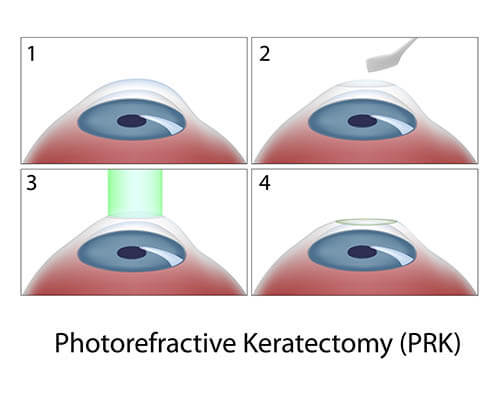
PRK, or photorefractive keratectomy, is another type of laser vision correction. With PRK, a flap is not created within the cornea. Instead, the epithelium, the outer layer of the cornea, is removed to expose the inner layers of the cornea. The same excimer laser that is used in LASIK is then utilized to reshape the cornea to correct for nearsightedness, farsightedness, and astigmatism. A bandage contact lens is placed on the eye, and the epithelium grows back over a period of two to three days. This procedure is more appropriate for patients who have thinner corneal thicknesses and who may not be candidates for the LASIK procedure. Testing during the pre-operative consultation will determine if a patient is a candidate for the LASIK or PRK procedure.

While LASIK is an excellent procedure to eliminate the need for glasses and contact lenses, there are certain limitations to candidacy. Some patients have prescriptions that are too strong for LASIK or have corneas that are too thin for LASIK. If you are not a candidate for LASIK or PRK, you may potentially be a candidate for other refractive procedures including Implantable Contact Lens.
An Implantable contact lens is a silicone implant that is placed behind the iris (the colored part of your eye) and in front of your natural lens. This technology does not change the shape of your cornea and can be removed if the power of your eyes changes. The power of this implant lens is carefully chosen to provide optimal distance vision. Occasionally this technique can be used in conjunction with LASIK for treating larger amounts of nearsightedness, farsightedness, and astigmatism.
A Clear Lens Extraction is voluntary cataract surgery, before the development of a cataract. In this procedure, the surgeon removes your natural lens and replaces it with an implant lens. The power of this implant lens is chosen to give you optimal distance and near vision. An implantable contact lens is an intraocular lens that is placed behind the iris (the colored part of your eye) and in front of your natural lens. This is potentially an option for patients that have prescriptions that are too strong for LASIK.
Dr. Goodman uses the latest technology including a femtosecond laser that optimizes both the vision and healing time with cataract surgery. If you undergo a clear lens extraction, there will be no need for cataract surgery in the future.